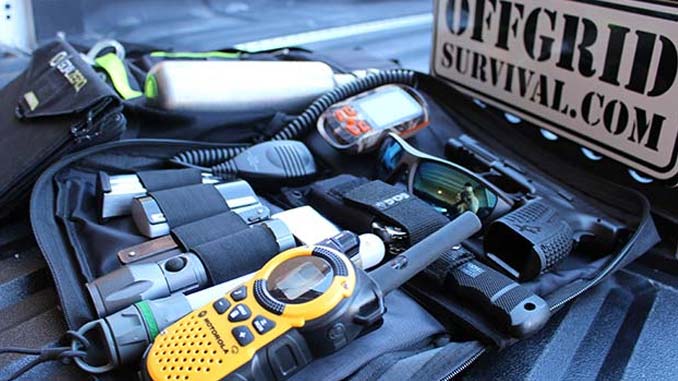
When it comes to survival books, T.V. shows, and survival websites, far too much attention is paid to wilderness survival issues. While these silks are important for people who spend time in the outdoors, for a vast majority of people these are not the skills they need to focus on.
Urban Survival & Wilderness Survival are two very different things.
Survival Gear is another area where people get caught up in the wilderness survival mentality. If you’re heading out into the wilderness, then by all means, stock up on gear for that environment. But if you’re planning to face most modern day threats, you need to really consider what those threats are and where you will be when they happen.
Most commercially sold survival gear is geared towards a wilderness audience.
With the popularity of so many recent survival television shows, a lot of people now have a really warped idea of what it takes to survive during a disaster. I mean how many people are really going to find themselves stranded, naked and afraid on a deserted island?
Let’s get real here. When disaster strikes, you will likely by at home, at work, or somewhere near your normal everyday environment. These are the places you need to be ready to survive in.
Here are 8 Pieces of Gear, Specifically suited for Urban Survival
Keep in mind these are only suggestions, some of these items are pretty expensive and are only highlighted because they are designed specifically for an urban setting. The main purpose is to get you thinking about the difference in gear types, and what types of items might be helpful during a long-term urban disaster.
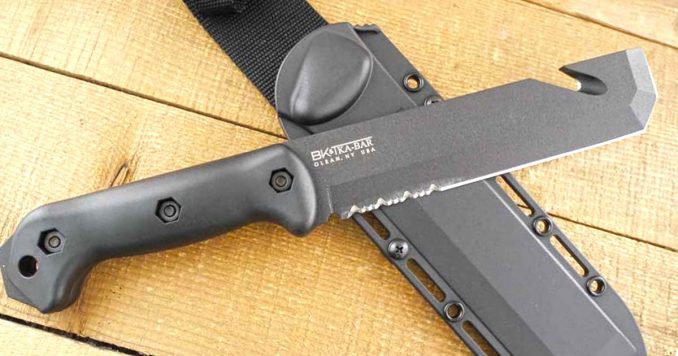
Ka-BAR Becker Tac Tool
The Ka-BAR Becker Tac Tool is a rescue and rapid entry knife designed by Ethan Becker of BK&T and John Benner of TDI. The Tac Tool is the knife of choice by rescue workers, special response teams, and military operators.
The knife is specifically geared towards urban survival issues and has a number of design features that would come in incredibly useful during a big city disaster.
- The knife is designed to smash, bash, pry, chisel, hammer and cut.
- It is great for lifting hinge pins and hammering out glass.
- Most relevant for urban survival, something most wilderness style knives would fail at, is its ability to be used as a pry bar. The knife features a blunt chisel pry-bar tip for prying open doors and windows.

Four Way Water Key
During a long-term disaster situation, water is going to be one of your most important considerations. In an urban environment, the ability to find drinkable water could mean the difference between life and death.
In an urban setting, this one tiny tool could be a game changer. A water spigot key is designed to gain access to both commercial and residential water faucets. This is especially helpful in getting water from commercial buildings, which usually remove external water handles or have recessed outlets to keep the homeless from using their water.
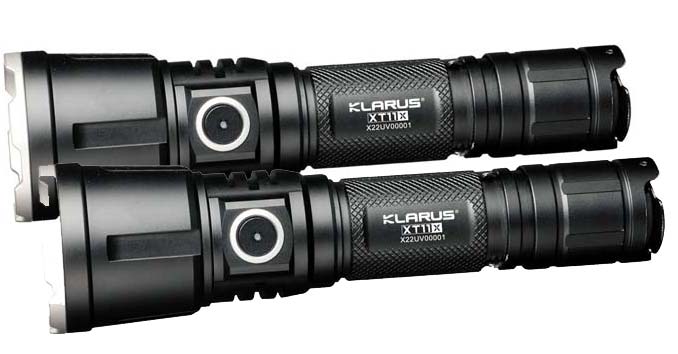
Tactical Flashlight
A flashlight is an essential piece of survival gear that everyone should be carrying as part of their everyday carry kit; but don’t just settle for any crappy little flashlight, you want to look for one that can serve multiple survival purposes – enter the Tactical Flashlight.
A good tac light will not only provide light, but can double as a self-defense tool in times of crisis.
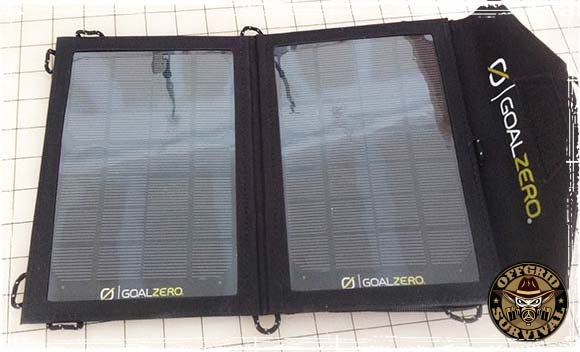
Portable Solar Charging Kit
During an urban survival disaster, there is a pretty good chance the power grid will go down. That’s why the Goal Zero Adventure Kit made the list of urban survival gear.
From recharging your AA & AAA batteries to powering up cell phones, GPS devices, and emergency radios, the Goal Zero is one of the best portable emergency solar chargers on the market. Check out our full review of the Goal Zero here, or check out our complete list of portable solar chargers.

SOG PowerLock Multi-Tool
What would an Urban Survival Kit be without a good Multi-tool?
The SOG Powerlocks are some of my favorite multi-tools on the market. They feature an interlocking gear system, which not only makes the tool extremely smooth to open and close, but more importantly it minimizes the amount of hand pressure that’s required to get the most torque out of the tool. In my opinion, it has the best, most robust pliers I’ve ever seen on a multi-tool.
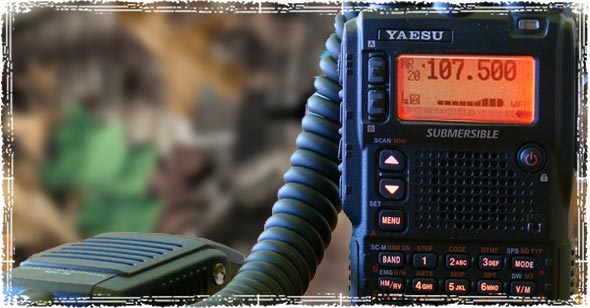
Yaesu VX-6R Multi-Band Submersible VHF/UHF Amateur Radio Transceiver
When the grid does down, and communication systems stop working, there is one mode of communication that will still be alive and well: Ham Radio.
These small Yaesu radios are one of the most popular choices on the market; don’t fall for the cheap Baofeng radios often pitched on prepper websites. Take it from a real Ham Radio operator; I’ve bought the Baofengs and they suck! Spend the extra money and go with a quality radio, one that Ham radio operators have been using for years, and one that you know you will be able to trust during an emergency. The dual band VX-8DR covers the 2 meter, 1.25 meter & 70cm ham bands (50/144/222Mhz/440Mhz), making it the perfect choice for any Bugout bag or EDC.

A Skateboard
I know, you’ve probably never seen a skateboard on any other list of survival supplies; well, I can tell you from experience that this is probably one of the most versatile and multi-purpose pieces of urban gear you can carry.
From being able to quickly make your way through a city to being one bad-ass undercover self-defense tool, a skateboard is one of my top pieces of urban gear. I can strap it to my pack or keep one in my vehicle, and in a pinch it’s right there waiting ready to roll!
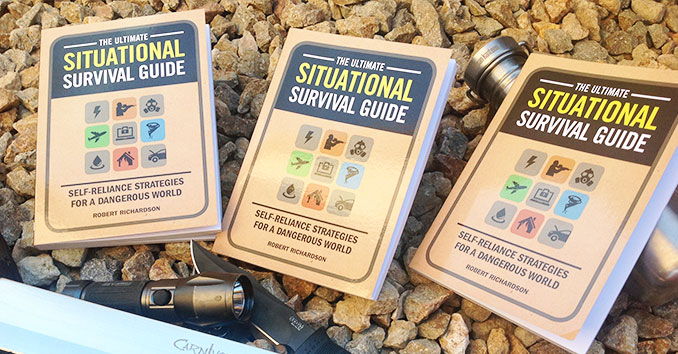
The Ultimate Situational Survival Guide: Self-Reliance Strategies for a Dangerous World
This is not another Wilderness Survival Book! I wrote The Ultimate Situational Survival Guide specifically to help people prepare for real-world disasters and threats.
From surviving natural disasters, man-made disasters and disease outbreaks, to essential tactics and step-by-step instructions for surviving urban disasters, crime, social unrest, and criminal/terrorist attacks, the book will help you learn the self-reliance strategies you need to survive in just about any urban survival situation.



an important note: take the time to learn about your radio if you acquire a HAM 2meter handheld. They operate a lot differently from CB radio and the time to learn isn’t during an emergency.
A Technician License does not a HAM make. If I have to explain it you wouldn’t understand!
Oh boy, here comes that arrogant chaste system. Some hams, like the one above, delight in having a higher ham license class than the entry level class. They incorrectly believe they are above the rest. I have an Amateur Extra Class and rarely use ham radio because of people like him. I prefer the CB and freeband. During a disaster licensing means little. The FCC allows anyone to use the frequencies during a true emergency.
No level makes no difference, but the fact that you talked to other hams learned new ideas, tried new ideas, even found a few tricks that have been around for 100 years makes you a Ham. Not the fact the you view Ham as a Chaste system and keep it to yourself.
Jodi is the type who can’t stand it when someone knows a little more than they do…. This is the type to stay far away from.
I concur with you.Jodi…mostly. I too am a HAM and it is important to practice with your gear and make friends. CB does have a place in a good comm plan.
Also if all you can afford is a “cheap” Baofeng radio to start with – go for it just like ALL of the rest of your gear until you can afford to upgrade AFTER you decide what works for you..
I am a relatively new Ham with just my Technician’s license as of now. By “expertise”, one could be meaning, which button do you push to talk ? How might you program the radio to hit a local repeater or two ? Seeing that hand-held radios usually only have about five watts of power and don’t reach more than a few miles on their own. They would be useful in an emergency, but that’s not the time to be familiarizing yourself with it :D.
Thank you
Educate me please, I am asking questions, not making statements. What is so difficult about operation a Ham Radio. Keep in mind that I’ve never even seen one. 2. Can they be triangulated and the gov’t can track us or find our location. 3. Are they durable out in the wilderness because for me bugging in is not an option. thanks and please somebody answer
Operating a ham radio is not rocket science per se but you do need a license to transmit but not listen. You will need some basic technical understanding of how Ham works and how to operate your radio unit. Yes, Ham radios can be triangulated just like all other radio bands. The govt does have tracking equipment and they can be pretty accurate but if you use prearranged codes and stick to all other rules of using Ham then you should be ok. But in a major disaster/survival scenario, the FCC or the ACMA (in Australia) will probably have better things to do than monitoring the airwaves for illegal activity or else in a real apocalypse scenario they (govt agencies) may cease to operate altogether.
In regards to whether a Ham Radio is durable or not largely comes down to the brand, model and features. I’d get one that is waterproof and dustproof if you’re going to be packing it into a bug out bag. I’m not sure whether the Baofeng UV-5R is waterproof or dustproof.
It’s all well and good if you’ve got $400.00 or more to spend on a Ham radio that’s portable. I for one can’t justify that expense, and I think most of us will just be listening in to emergency transmissions. How about a nice operable SW receiver like a PL-660 that has Synch lock, SSB mode etc? If I want to transmit locally my CB will do just fine and I save $300.00 or more for nessisities.
Well said…. It sure is a tad more involved than holding down the transmit button and talking.
Hams use a variety of frequencies for communications. Non-hams can “listen in” via their own receivers or radio scanners. Hams are able to use many frequency bands across the radio spectrum — these frequencies are allocated by the FCC for amateur use. Hams may operate from just above the AM broadcast band to the microwave region, in the gigahertz range. Many ham bands are found in the frequency range that goes from above the AM radio band (1.6 MHz) to just above the citizens band (27 MHz). During daylight, 15 to 27 MHz is a good band for long-distance communications. At night, the band from 1.6 to 15 MHz is good for long-distance communications. These bands are often referred to historically as short-wave bands (as in “short-wave radio”). Unlike frequencies used by FM radio stations and TV stations, which are line-of-sight and therefore limited to 40 or 50 miles, short-waves “bounce” off the ionosphere from the transmitter to the receiver’s antenna. The higher the frequency is, the “shorter” the wavelength is.
Some ham radio operators use the very reliable Morse code, while others use voice. Morse code signals (beeps) often get through when voice transmissions cannot. There are also very many digital modes as well, and hams use radio modems to communicate in various networks. a quick Google search gave me this. Hope this helps since a simple answer from someone who actually uses one is to damn hard to get? Information is free, and it dont hurt to be nice.
Although a ham radio does broadcast in all directions, hams generally do not use their radios in a broadcast kind of way as a disk jockey would at a radio station. In normal AM or FM radio, one disk jockey transmits and thousands of people listen. Hams, on the other hand, conduct two-way conversations, often with another ham or with a group of hams in an informal roundtable. The roundtable of hams may be in the same town, county, state, country or continent or may consist of a mix of countries, depending on the frequency and the time of the day. Hams also participate in networks, often called nets, at predetermined times and frequencies to exchange third-party messages. In the case of disasters, hams exchange health and welfare information with other hams. Some hams use radioteletype, (RTTY) with computer screens replacing the noisy teletype machines of the past.
Many hams get their start on VHF FM, using battery-operated hand-held transceivers set to transmit on one frequency and receive on another frequency. They use FM repeaters, set up and supported by local radio clubs. These repeaters borrow antenna space from TV-station-tower owners on top of mountains and high buildings to receive and re-broadcast signals to extend the range.
When deadly floods struck central and southern Texas in mid-October 1998, amateur radio operators from four states volunteered their time. Susan Manor, NF0T, is shown helping with communications at the New Braunfels Red Cross office.
When deadly floods struck central and southern Texas in mid-October 1998, amateur radio operators from four states volunteered their time. Susan Manor, NF0T, is shown helping with communications at the New Braunfels Red Cross office.
The FM repeater receives one signal at a time and simultaneously rebroadcasts it on another frequency using many more watts of power than available from a small hand-held radio. This extends the range of the hand-held radio from a few miles to tens or hundreds of miles! The whole country has these repeaters! (Listen to one with a radio scanner to learn a lot about ham radio.) When a ham is traveling, he or she can find a repeater to use (great for tips on local restaurants), and carry on a nice, static-free, FM-radio-quality conversation via a radio that fits in the shirt pocket or purse. Linked repeaters allow fun wireless communications across an entire state with a hand-held radio.
Repeaters use common transmit and receive frequency pairs. The frequency pairs in use are informally assigned by groups of hams so that any frequency pair in use is far enough from another repeater so as not to cause unwanted interference.
Amateur radio satellites are a cutting-edge use of technology in amateur radio. Radio amateurs use their hand-held radios to communicate through an amateur radio satellite when the satellite is overhead. A current British satellite has a receiver (uplink) at 145.975 MHz and simultaneously rebroadcasts (downlink) at 435.070 MHz for one station at a time, as a repeater.
Natural disasters like hurricanes or tornadoes disrupt normal telephone and cell phone systems. Ham radio operators pitch in to help with emergency communications, and you will often hear about them on news reports.
On Space Shuttle missions, each member of the crew usually has an amateur radio operator’s license. During breaks, astronauts hold their 1- to 5-watt VHF FM hand-held radios up to the shuttle window and chat with other hams for a few minutes, often at schools while the shuttle is in an orbit overhead! VHF transmissions have a limit to line-of-sight communications and normally do not travel over the horizon, so a conversation is limited to the time when the shuttle is overhead. The space station MIR used 145.985 MHz for similar conversations. Future ham radio efforts in space will focus on the use of amateur radio within the International Space Station (ARISS) project.
Good list, you bet I will be buying that 4 way water key soon.
When looking for a water key make sure its steel and make sure its a true “stem” key and not a service cabinet key. A true water key has 1/4, 9/32, 5/16, and 11/32 tips for commercial water stems. A service cabinet key has a square hole, triangle hole, and a double barb for water, electric, and gas service cabinets. I would recommend getting both for SHTF they will be very handy especially when all the toilets and water heaters are empty.
That MACK-1 in the wrong hands is a nightmare. In an urban environment, during times of crisis, my biggest concern would be two legged animals in packs. On foot bugging out strikes me as suicidally foolhardy. Caught in a car, at an intersection, yikes! I think your best bet is to stay indoors until things mellow out. Besides radios, flashlights, food, and water; my attention would be security. Not guns and ammo- bars on windows and doors. Keeping trouble out my first precaution. If I had a lot of money, instead of buying a hundred thousand dollar sports car, I would opt for a vehicle with bulletproof features. Paranoia is preferable to quadrapligia.
Totally agreed with one exception. If you pick up on whats about to happen and can bug out before its obvious to everyone what’s happening, that is the best option. Slim chance, but ideal.
The only thing I would add is that sometimes staying in place is not an option. As Rick pointed out, getting out of dodge before the masses may save a life. For urban bug out I would consider a scooter/bike to exit the city while avoiding the pitfalls that will stop cars, trucks, or up-armored vehicles. Just my two cents. Thanks.
Terradyne makes civilian armored vehicles.
Some of these items look very good to use in many situations, not just disasters. The HAM radio, and the water key I think I will be ordering very soon. The survival book looks very interesting also.
I sure appreciate this article and the information that it gives. I also appreciate the readers added commentary like Scoutsout suggestion for the “water key”…great advice.
Yes Hams can be triangulated. My dad and his HAM group used to play a game called Fox & Hounds. One person would be the fox and drive around the city and the others would try to find him. He took us 5 kids one time and that time he won got back to the “den” before anyone could find him. It was a lot of fun ’cause the guys were looking for the station wagon full of kids. Pop had us hide down in the seats so no one spotted us.
Yup, raido comm of the “Ham” verity is very important. I’m not licensed my self but am a trains raido operator. I prefer the UV8R to the UV5R handheld, I have more powerful I dash unite in my vechical’ s and bi-linear amplifiers to boost the power. Base stations and wave guide antennas at the cabins. That’s just me.
Might I suggest that for those that are interested in learning more about becoming a “Ham” operator might find those that already are will be happy to answer your questions or suggest those web sights which will. If not Google is very helpful
As o the othe items listed here I wanted to comment on the SOG Multi-Tool. The SOG is a great choice but if your going to shop a bit before making your decisions I’d like to suggest my choices. For backpack or BOB I prefer the Leatherman Wave, for the vechials, the Gurber with the heavy Linesman pliers, for the belt and EDC I carry the Leatherman MUT. Most will not need the MUT as it is a design spicific tool with crossover to tools such as the Wave.
Larger tools …… Check out the Stanly FatMax, the Zoro, or the Dead-On Annihilator. In a “fend for yourself” one will need a tool such as this to gain access to those areas and resources which may prove difficult to aquire otherwise.
I thought everyone had a 4-way water key but maybe not. A very useful and inexpensive tool have in ones kit. In an urban environment I’d also suggest a fire hydrant wrench, very useful.
Thanks for reading, Have a good day,
I like the knife and the flashlight. They are pretty darn cool.
The Baofeng GT-3 MarkII. Is a really nice radio. These radios are in there 2nd and 3rd generation now. I see no difference in quality between this radio and the vx-8 I had.
The thing about ham radio; is if you take the time to earn even an entry Tech license, you learn a bit about improvising antenna systems, tapping into alternate power supplies, and other handy stuff to know should you have to improvise anything electrical or communications related. It’s not all just talking on the radio.
Im a big fan of the ‘four way water key” pretty cool method of finding water! What would you suggest using during an earthquake? One could assume a vast majority of the infrastructure ‘pipes’ where broken or shut off… in the aftermath. Any ‘well pumps’ out there that you would suggest…?
May I suggest an Ardis tool vs. a regular hydrant wrench, Pete. Lighter, folds, and had a hook, among other things. Used one for several years in the fire service.
Really good tips. I am a ham too! As a matter of fact I come from a family of hams, mom, dad brother, sister in-law, one and one, we are all hams. We all own Baofengs radios besides the expensive big brand ham equipment. I have 2 myself, one portable (hand) and one mounted in my Jeep, both are good quality reliable pieces. We’ve all recommended them, just my 2 cents!
THANK YOU for this article
!! You are so right, most survival gear is designed for rural survival. At one time my family and I planned for rural survival but circumstances changed with the death of family members. Things had to be sold to cover expenses and remaining family have moved on.
Now I face hunkering down in an urban area so I need to relearn a few things and resupply myself. This is at least a start. Am currently studying for an entry ham license, so that will help with communication. What would you suggest as transportation for a very clutsy urban traveler? A two-wheeled bike won’t get it. Advice is most welcomed.
A walking stick or cane is legal everywhere and with a little practice can be an effective self defense weapon. A Lightweight 4-way spigot opener would be quite useful. The CRKT pry bar/knife seems to be perpetually out of stock…
As regards Ham radio, I am licensed, but in an emergency the FCC has said, go ahead, use the radios to communicate to protect lives and property. Having said that, the radios are like any tool. it pays to get familiar with them ! The minimum Technician test isn’t that difficult nor is it expensive. Get to know some Hams, they’ll be happy to discuss their hobby with you. Many of us also have an interest in emergency communication and preparedness aka prepping.
You should adjust the kit so the flashlight uses the same batteries that the goal zero panel will recharge. Current flashlight is 18650. You can get same lumen output with several AA lights and I would switch to one of those. I would also make sure the radio uses AA in an expansion battery pack. I know above ground does. Finally I include a combo AM, FM SW Marine and NOAA radio in my kit. Several are multiple power source, solar ,crank, battery. And will also supply USB power to supplement the solar panel.. I also add two GMRS radios and have programmed my baofeng to operate on those channels in an emergency. That gives you a 1 mile comm radius for 3 groups. Can also be used when family vacations in national parks. I have the gmrs license but in an emergency that wouldn’t be needed. The blister pack gmrs radios are a cheap addition that is easy to use
Generally good ideas. Urban survival has some significant difference from wilderness survival.
However, a few things I would suggest:
1) The black 4-way tool shown with the recommendation to have a 4-way sillcock is an electrical panel key tool to open various types of locks that keep people out of electrical boxes. Having one of them is nice, but do get an actual 4-way sillcock key.
2) I will not get into the argument about Amateur Radio, as it is a never-ending battle and will never be resolved. However, I will say that 2-meter and 70-centimeter handheld radios are not that easy to use by those that have not learned what to expect and how to use them. While 2-meter radios are very common, probably the most common Amateur Radio out there, the majority of Amateurs that use them are talking to other operators through a repeater system of one type or another.
Yes, they can be, and are often, used directly in what is called simplex mode. The radio is set to a single frequency and you transmit and receive on that same frequency. Repeaters work differently. All the radios in the field transmit on one frequency, which the repeater receives and transmits on a different frequency, which is received by the radio in the field.
If one does not know both the transmit frequency and the receive frequency, and how to program them into the radio correctly, you might be able to listen, but will not be able to talk to the other person. Since the terms transmit frequency and receive frequency are often not used when referring to this system, but the terms ‘the repeater frequency and the offset’ it can be confusing. Especially since the amount of the offset can vary, and the direction of the offset (either above or below), a person has to know how to get those parameters in their radio.
Add in the fact that some repeaters require a set of audible tones to be transmitted to activated the repeater, which will be different for just about every repeater that uses them, the operator has to know which tones are required for which repeater.
It really is not that difficult, but someone that buys a 2-meter handheld radio and expects to put it away in a Faraday cage and bring it out, turn it on, and start talking to other people is not going to be very successful. Even if you can get someone to program the radio before you put it away is no guarantee that you will be able to use it. If you pull the battery for long-term storage (as you should) it is likely that the radio will lose the programming and will need to be reprogrammed when it needs to be used. Even if it does not lose it then, there are a large number of things that can cause a radio to lose its programming, not the least of which is simply touching the wrong button at the wrong time when trying to use the radio.
Since I seem to always have my own opinion on what options might go on various lists, here is one of my urban prepping lists. Be aware that this in addition to my extensive EDC.
1) SAS Urban Survival Handbook
2) Petzl TacTikka + RGB headlight
3) AC & DC cell phone chargers/battery backup/cords for cell phone
4) Leatherman Rebar Multitool
5) Victorinox Outrider Swiss Army Knife
6) Spyderco Harpy folding knife (serrated hawk bill – rope/line/self-defense)
7) 4-way Silcock key
8) Yaesu FT-3DR handheld Amateur 2m/70cm radio w/HF receive
9) Uniden Bearcat BCD325P2 Public Service Band scanner w/Weather Alert
10) Bio protection kit w/P-100 safety masks, safety glasses/goggles, exam gloves, & hand sanitizer
11) First aid kit w/trauma items, prescription and OTC medications
12) 40 oz stainless steel Kleen Kanteen w/carabiner top
Just my opinion.